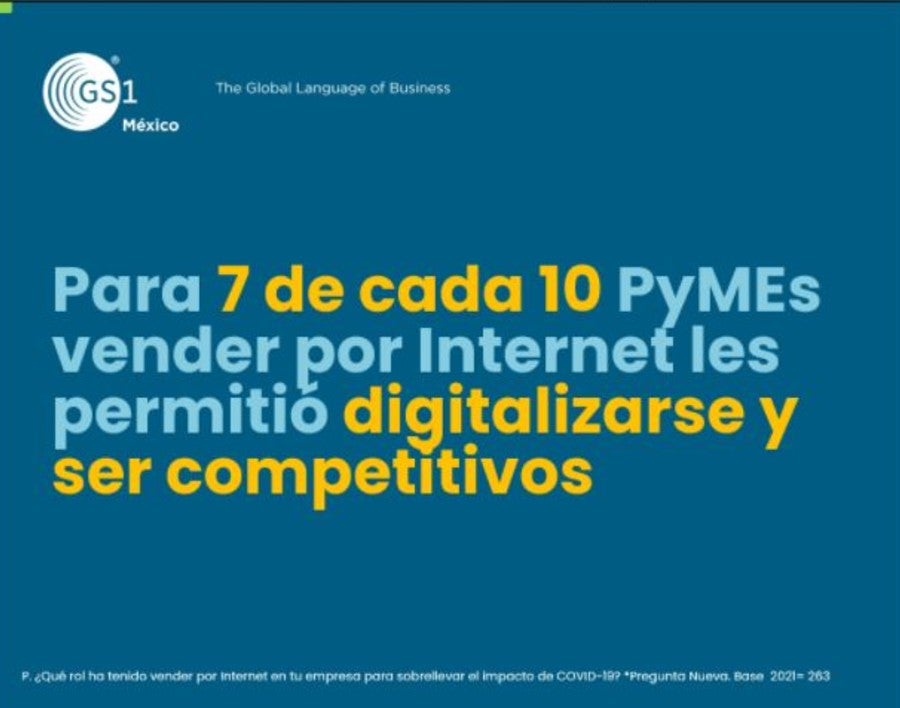5 min read
The adoption of the digital channel by Small and Medium Enterprises (SMEs) in Mexico found an exponential force in the pandemic. According to the Study on Online Sales in SMEs 2021, prepared by the Mexican Online Sales Association (AMVO), in collaboration with GS1 Mexico , in the first half of the year, these companies reported a 100% growth in sales generated by the digital channel, and they expect online sales to represent 35% of all their sales by the end of the year.
“ With the aim of detonating strategies and initiatives that promote electronic commerce in Small and Medium-sized Companies, in the AMVO and GS1 Mexico we undertook the task of developing the Study on Online Sales in SMEs 2021, which shows a stabilization in the number of SMEs selling online; This demonstrates the need to continue evangelizing, without losing focus on the need to continue creating training spaces, so that more and more SMEs in Mexico can join the digital ecosystem ” , says Pierre Blaise, general director of AMVO.
For seven out of 10 SMEs, selling online allowed them to digitize and be competitive , while for 34% it represented their only source of income during the pandemic . Likewise, 3 out of 4 maintain that selling online allowed them to reach audiences that they considered out of their reach.

GS1 Mexico
“In the new normal, the name of the game for SMEs is called omnichannel, since 9 out of 10 Mexican companies sell their products through the combination of physical channels -stores, showrooms, points of sale- and digital channels – marketplaces, delivery apps and / or internet pages-; This has allowed them to consolidate their digital transformation, focus their strategy on new consumer habits and generate a memorable shopping experience ”adds Juan Carlos Molina, General Director of GS1 Mexico.
Although most of these companies (42%) have been selling online for 2-5 years, 48% of SMEs started selling online due to the arrival of the pandemic and 2 out of 10 claim to have started their digital channel during 2021.
Regarding the profile of SMEs, it stands out that 58% sell online and 42% do not sell through the digital channel . Of those that sell online, the majority are concentrated in the Central area of the country and the Valley of Mexico, and belong mainly to the food and beverage business (42%). 44% employ 1 to 5 people, 38% up to 30 people and 18% more than 30.
The concentration of commerce directed to the final consumer within the digital channel is evident, since 61% stand out to adhere to the B2C ( Business to Consumer ) model .
90% of SMEs sell through various channels, including the Internet ; 39% of its total income comes from large retail chains or distributors. Sales through e-commerce sites and social networks stand out, representing 21% of their total income .
For SMEs that sell online, social networks are the most common channel (85% use them) , followed by their own websites (72%) and marketplaces and eRetailers (70%), being Mercado Libre (73%) and Amazon (54%) the multi-category sites they use the most .
Logistics and marketing tools
Now, in terms of logistics and marketing tools, the study highlights that 77% of these companies have their own warehouse and 38% have their own transport, thus, 70% adhere to a logistics model that includes shipping own product through courier and parcel service ; however, they are limited to close distances.
Among the main logistical challenges they face are high shipping costs (56%) , shipping damage (36%) and a lower product price compared to the cost of shipping (36%).
Regarding the main digital strategies they use to strengthen their presence on the Internet, they highlight starting or strengthening online sales (53%); keep their digital presence up-to-date (52%) ; and strengthen its online sales channel (46%).
On the other hand, the traditional strategies focused on reinforcing the online presence that are carried out the most are to diversify the supply of providers (39%); optimize operational processes (38%); and improve the logistics strategy (36%).
When it comes to advertising, 69% rely on an official Facebook page; 54% bet on advertising on social networks; and 48% bet on an official page on Instagram.
 Depositphotos.com
Depositphotos.com
Another point to highlight within the study is that, until recently, the first step for SMEs that did not have a digital presence was to start with social networks , therefore, 43% consider them very easy to implement. In contrast, online exports (29%), selling through virtual events (28%) and through last mile applications (29%) are the channels with the most difficulty to implement.
When it comes to the most used traditional advertising channels, word of mouth recommendations stand out (53%) ; presence at events (30%); and promotional marketing (29%), such as participation in stores and activations.
The promotional tool most offered by SMEs is free delivery (61%) , followed by seasonal discounts (36%). Meanwhile, the most widely offered payment methods are bank deposit (64%) and electronic bank transfer (63%).
Regarding the level of preparation to sell online, 68% of SMEs consider that they are fully or moderately prepared to sell online . However, they consider that training must be constant, especially in topics such as online negotiation, KPI’s generation, electronic commerce and finance.
Finally, SMEs that do not sell online highlight ignorance due to lack of time as the main reason they have not explored the digital channel, but 74% express their willingness to do so during the remainder of 2021 .
Download the executive summary here .


0 Comments